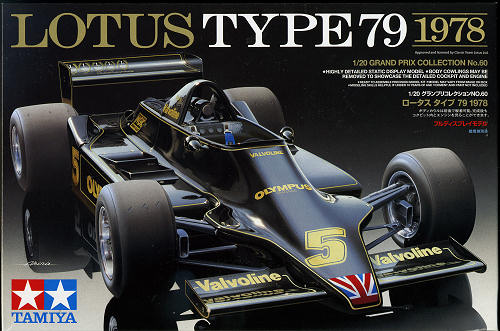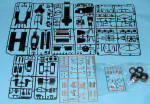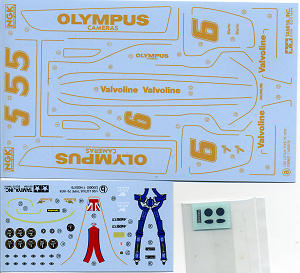
Tamiya 1/20 Lotus Type 79 - 1978
| KIT #: | 20060 |
| PRICE: | 4000 yen from Hobby Link Japan |
| DECALS: | Four options |
| REVIEWER: | Scott Van Aken |
| NOTES: |

| HISTORY |
The 79 proved to be almost unbeatable during the 1978 Formula One season and provided an unprecedented level of domination. The car took six more victories during the season giving the drivers' championship to Andretti, and the constructors' championship to Lotus. Its only serious rivals during the season were the Ferrari 312T3 and the Brabham BT46B 'fancar'. The fan car only raced once, winning the 1978 Swedish Grand Prix, before the FIA banned the concept. Meanwhile, the Ferraris only won when the Lotus failed to finish. So superior was the Lotus, that most races became a scrap for minor placings, as Andretti and Peterson regularly finished first and second, more often than not by a considerable margin ahead of the rest of the field. On the rare occasion the 79 did not win or fail, one or other driver was usually on the podium. Andretti was comfortably world champion in 1978, and Peterson finished the season as the runner-up although posthumously as he was tragically killed in a startline crash at Monza, ironically, the race where Andretti wrapped up the championship. Incidentally, Peterson was not in the 79 for that race, but in fact last year's 78 due to a heavy crash in practice and him being unable to fit into Andretti's spare car. Jean-Pierre Jarier took over the second Lotus for the rest of the season and was leading the race in both America and Canada (he also grabbed pole position in Canada) until the 79 suffered mechanical failures in both. It proved, however that even with a lesser driver, the 79 was still competitive.
In 1979, the 79 was to be replaced by the Lotus 80, intended to be the next step in the evolution of ground effects. Martini Racing replaced JPS as sponsor in that year, so the car appeared resplendent in British racing green. The 80 proved to be a total failure and Lotus was forced to go back to the 79, driven by Andretti and Carlos Reutemann. Several podium places were scored and the 79 was in contention for victory in the early stage of the season, but unfortunately the next generation in ground effects cars led first by the Ligier JS11, then Ferrari 312T4 and then Williams FW07 (a car heavily based on the 79) outclassed the Lotus. Although the car was updated with revised bodywork and a new rear wing, Lotus slipped to fourth in the constructors' championship and the car was retired at the end of the 1979 season, without winning any further races.
In its lifetime, the 79 took 7 wins, 10 pole positions, 121 points and won the last drivers' and constructors' world championships for Lotus. The 79 is credited with pushing Formula One into the aerodynamics era, and its influence is still keenly felt on today's modern F1 cars. After Rubens Barrichello drove the 79 at the Goodwood Festival of Speed in 2000, he came away raving about its phenomenal grip and traction, and stated it felt like a modern Grand Prix car.
| THE KIT |
 Interestingly,
both Tamiya and Hasegawa have come out with the same car in the same scale at
the same time. Who would have thought that would happen? Tamiya has a more solid
reputation for doing 1/20 scale Formula One cars and this is #60 in their
series. Molded in black plastic with a sprue of chrome for wheels, and one of
grey for most of the engine parts, it is everything that model builder have come
to expect from Tamiya products. Each of the sprues is individually bagged,
something you will not find in the Hasegawa kit. The molding is superlative and
from the look of things, the engineering will be such as to make construction a
most pleasant experience.
Interestingly,
both Tamiya and Hasegawa have come out with the same car in the same scale at
the same time. Who would have thought that would happen? Tamiya has a more solid
reputation for doing 1/20 scale Formula One cars and this is #60 in their
series. Molded in black plastic with a sprue of chrome for wheels, and one of
grey for most of the engine parts, it is everything that model builder have come
to expect from Tamiya products. Each of the sprues is individually bagged,
something you will not find in the Hasegawa kit. The molding is superlative and
from the look of things, the engineering will be such as to make construction a
most pleasant experience.

The kit is not a curb side and comes with complete engine detailing. A set of preformed screens for atop the injector stacks is also part and parcel of the kit. An etched fret is available from Tamiya as a separate set and these parts are indicated in the instructions. There are vinyl tires that are pneumatic and there is also a length of small diameter hose to use for the plug wires. The differences between the cars at the British and German Grand Prix are minimal, but Tamiya has included the small bits that differentiate between the two. Means that you need to know which version you will be building pretty early in construction. These differences are mainly the roll bar area and the steering wheels used.
External markings are identical for the two races. You can build either Mario Andretti or Ronnie Petersen's car for the British or German Grand Prix. The decals look to be very well done and should perform superbly. I particularly like that the harness and all the body fasteners are done as decals. A nice touch. Typical Tamiya instructions with excellent drawings and detail bits to help you properly assemble the kit. This also means no paint information except Tamiya paint.
| CONCLUSIONS |
In all, this is another superb Tamiya F.1 car kit. I particularly like this model as I had a chance to see this car run in Long Beach during 1978 and was quite impressed by its performance. It will make into a superlative model.
| REFERENCES |
http://en.wikipedia.org/wiki/Lotus_79
June 2010
Thanks to www.hlj.com for the preview kit. Get yours at this link.
If you would like your product reviewed fairly and quickly, please contact me or see other details in the Note to Contributors.